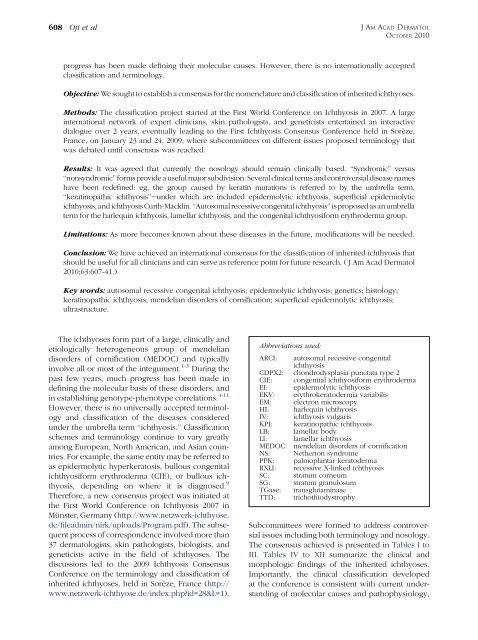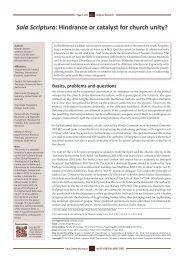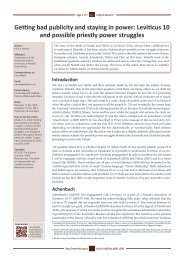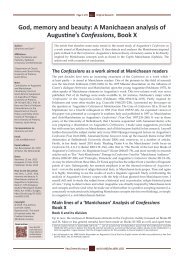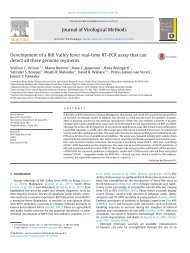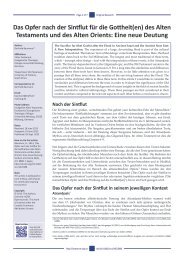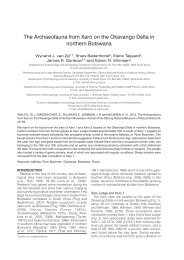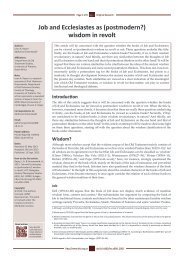Revised nomenclature and classification of inherited ichthyoses ...
Revised nomenclature and classification of inherited ichthyoses ...
Revised nomenclature and classification of inherited ichthyoses ...
You also want an ePaper? Increase the reach of your titles
YUMPU automatically turns print PDFs into web optimized ePapers that Google loves.
608 Oji et al<br />
progress has been made defining their molecular causes. However, there is no internationally accepted<br />
<strong>classification</strong> <strong>and</strong> terminology.<br />
Objective: We sought to establish a consensus for the <strong>nomenclature</strong> <strong>and</strong> <strong>classification</strong> <strong>of</strong> <strong>inherited</strong> <strong>ichthyoses</strong>.<br />
Methods: The <strong>classification</strong> project started at the First World Conference on Ichthyosis in 2007. A large<br />
international network <strong>of</strong> expert clinicians, skin pathologists, <strong>and</strong> geneticists entertained an interactive<br />
dialogue over 2 years, eventually leading to the First Ichthyosis Consensus Conference held in Sorèze,<br />
France, on January 23 <strong>and</strong> 24, 2009, where subcommittees on different issues proposed terminology that<br />
was debated until consensus was reached.<br />
Results: It was agreed that currently the nosology should remain clinically based. ‘‘Syndromic’’ versus<br />
‘‘nonsyndromic’’ forms provide a useful major subdivision. Several clinical terms <strong>and</strong> controversial disease names<br />
have been redefined: eg, the group caused by keratin mutations is referred to by the umbrella term,<br />
‘‘keratinopathic ichthyosis’’eunder which are included epidermolytic ichthyosis, superficial epidermolytic<br />
ichthyosis, <strong>and</strong> ichthyosis Curth-Macklin. ‘‘Autosomal recessive congenital ichthyosis’’ is proposed as an umbrella<br />
term for the harlequin ichthyosis, lamellar ichthyosis, <strong>and</strong> the congenital ichthyosiform erythroderma group.<br />
Limitations: As more becomes known about these diseases in the future, modifications will be needed.<br />
Conclusion: We have achieved an international consensus for the <strong>classification</strong> <strong>of</strong> <strong>inherited</strong> ichthyosis that<br />
should be useful for all clinicians <strong>and</strong> can serve as reference point for future research. ( J Am Acad Dermatol<br />
2010;63:607-41.)<br />
Key words: autosomal recessive congenital ichthyosis; epidermolytic ichthyosis; genetics; histology;<br />
keratinopathic ichthyosis; mendelian disorders <strong>of</strong> cornification; superficial epidermolytic ichthyosis;<br />
ultrastructure.<br />
The <strong>ichthyoses</strong> form part <strong>of</strong> a large, clinically <strong>and</strong><br />
etiologically heterogeneous group <strong>of</strong> mendelian<br />
disorders <strong>of</strong> cornification (MEDOC) <strong>and</strong> typically<br />
involve all or most <strong>of</strong> the integument. 1-3 During the<br />
past few years, much progress has been made in<br />
defining the molecular basis <strong>of</strong> these disorders, <strong>and</strong><br />
in establishing genotype-phenotype correlations. 4-11<br />
However, there is no universally accepted terminology<br />
<strong>and</strong> <strong>classification</strong> <strong>of</strong> the diseases considered<br />
under the umbrella term ‘‘ichthyosis.’’ Classification<br />
schemes <strong>and</strong> terminology continue to vary greatly<br />
among European, North American, <strong>and</strong> Asian countries.<br />
For example, the same entity may be referred to<br />
as epidermolytic hyperkeratosis, bullous congenital<br />
ichthyosiform erythroderma (CIE), or bullous ichthyosis,<br />
depending on where it is diagnosed. 9<br />
Therefore, a new consensus project was initiated at<br />
the First World Conference on Ichthyosis 2007 in<br />
Münster, Germany (http://www.netzwerk-ichthyose.<br />
de/fileadmin/nirk/uploads/Program.pdf). The subsequent<br />
process <strong>of</strong> correspondence involved more than<br />
37 dermatologists, skin pathologists, biologists, <strong>and</strong><br />
geneticists active in the field <strong>of</strong> <strong>ichthyoses</strong>. The<br />
discussions led to the 2009 Ichthyosis Consensus<br />
Conference on the terminology <strong>and</strong> <strong>classification</strong> <strong>of</strong><br />
<strong>inherited</strong> <strong>ichthyoses</strong>, held in Sorèze, France (http://<br />
www.netzwerk-ichthyose.de/index.php?id=28&L=1).<br />
JAM ACAD DERMATOL<br />
OCTOBER 2010<br />
Abbreviations used:<br />
ARCI: autosomal recessive congenital<br />
ichthyosis<br />
CDPX2:<br />
CIE:<br />
EI:<br />
EKV:<br />
EM:<br />
HI:<br />
IV:<br />
chondrodysplasia punctata type 2<br />
congenital ichthyosiform erythroderma<br />
epidermolytic ichthyosis<br />
erythrokeratodermia variabilis<br />
electron microscopy<br />
harlequin ichthyosis<br />
ichthyosis vulgaris<br />
KPI:<br />
LB:<br />
LI:<br />
MEDOC:<br />
NS:<br />
PPK:<br />
keratinopathic ichthyosis<br />
lamellar body<br />
lamellar ichthyosis<br />
mendelian disorders <strong>of</strong> cornification<br />
Netherton syndrome<br />
palmoplantar keratoderma<br />
RXLI:<br />
SC:<br />
SG:<br />
TGase:<br />
TTD:<br />
recessive X-linked ichthyosis<br />
stratum corneum<br />
stratum granulosum<br />
transglutaminase<br />
trichothiodystrophy<br />
Subcommittees were formed to address controversial<br />
issues including both terminology <strong>and</strong> nosology.<br />
The consensus achieved is presented in Tables I to<br />
III. Tables IV to XII summarize the clinical <strong>and</strong><br />
morphologic findings <strong>of</strong> the <strong>inherited</strong> <strong>ichthyoses</strong>.<br />
Importantly, the clinical <strong>classification</strong> developed<br />
at the conference is consistent with current underst<strong>and</strong>ing<br />
<strong>of</strong> molecular causes <strong>and</strong> pathophysiology,


